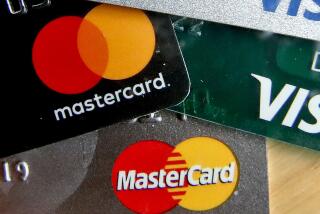Unions Push Own Credit Cards at Lower Rates in Exercise of Membersâ Mass Buying Power
Americaâs unions may well enter a new, happier era as they start exercising their mass purchasing power while they continue in their primary role as representatives of workers in dealing with both employers and government.
There are initial signs of success in the AFL-CIOâs ambitious programs designed to focus the collective buying power of its 13.5 million members to entice companies to provide good buys on everything from individual savings and investment accounts to discount travel.
If the plans succeed, unions could become a major new force on the consumer front.
And high time, too. These are troubled days for union workers battling the anti-union Reagan Administration and the many hard-nosed corporations that are fighting to cut wages and fringe benefits or to get rid of unions entirely. Fresh ideas put into action just might revitalize the labor movement.
Unions already have started to use âpension powerâ to increase their influence, but that role has been very limited so far. Unions could have an even more significant impact on the entire economy if they take a much more active part in the investment of billions of dollars held for their members in pension fund reserves.
The labor federation is off to what what looks like an excellent start with a Union Privilege MasterCard that currently offers union members a 12.5% interest rate compared to the national average of about 18%. The union card rate is variable, pegged at 5% above the prime interest rate.
The harshest critics of high credit card rates have warm praise for the unionsâ efforts.
âThe union MasterCard is easily the best buy in the nation of any widely available credit card,â says Ken McEldowney, executive director of San Francisco-based Consumer Action, a member of a consumer group coalition that last week launched a nationwide campaign to fight high interest rates on credit cards.
A few banks and other financial institutions offer rates comparable to the Union Privilege MasterCard. But most donât solicit customers nationwide and are in the vicinity of the bank making the offer.
McEldowney is particularly delighted that union MasterCard holders are urged to use their union cards to pay off debts theyâve accumulated on other cards that carry much higher rates. The consumer groups believe that if the use of union cards continues to spread, it could ultimately force the big banks and other financial institutions to lower their own rates.
Concept Not New
The concept of unions offering members benefits they donât get from their employers is not new. Many of the countryâs first unions started in the early 1800s as benevolent societies. Even then, though, the fledgling unionsâ real aim was to unite individual workers so collectively they could deal with employers.
As benevolent societies, the early unions provided financial help for medical care and money for burying members who died. Those costs were covered by workersâ dues.
Since then, unions in limited ways have managed to get discount rates for members for items ranging from eyeglasses and tires to Disneyland and Magic Mountain tickets.
Thus, while the fundamental idea of using the group purchasing power of unionized workers to get lower prices isnât new, the AFL-CIOâs current plan is radically different because the planned scale of operations is vastly greater than in the past.
To implement the program, the labor federation has created the nonprofit Union Privilege Benefit Programs, headed by Ray Denison, former chief lobbyist for the AFL-CIO.
Denison recently sent out letters to banks and other financial institutions throughout the United States, offering them the âopportunity to submit a proposal to provide financial products and services for members.â
The âfinancial productsâ include individual savings and investment accounts, loan programs, money management accounts and Individual Retirement Accounts, or IRAs. The federation also wants companies to bid on a wide variety of insurance programs, travel opportunities and other ideas devised by the businesses themselves.
Once bidders are selected and contracts signed, the Union Privilege Benefit Programs will âaggressively promoteâ them among union members. It will also closely supervise the operations to make sure members get what they signed up to buy and that no other equally reliable company will offer a better deal.
Workers who choose investment or savings plans may fund them through payroll deductions, if employers agree.
Social Concerns
Those firms seeking to sell the millions of union members investment accounts will not have much of a chance if they donât reflect laborâs âsocial investing concerns,â Denison says. Oversimplified, that means unions donât want investments in racist South Africa or in anti-union corporations.
Most of the AFL-CIO mass purchasing plans have yet to be implemented, although a free-to-members, limited legal services program will be offered soon and some insurance program proposals are being evaluated.
But leading the way to that possible new era for unions are the Union Privilege MasterCards. Almost all of the MasterCards issued so far have gone to union members who responded to solicitations by mail. Experts say a 1% to 2% response rate can usually be expected from consumers who get letters offering goods or services for sale.
But about 18% of the 3.3 million union members so far offered the Union Privilege MasterCard have asked for it, according to Theodore W. Kheel, president of Affinity Group Marketing, which sends the solicitation letters.
More than 300,000 cards already have been distributed. About 8% of those who requested a card didnât get one because the card issuer, the Bank of New York, found their credit ratings to be too low.
Fifty-two of the AFL-CIOâs 92 affiliates have joined the credit card project so far, but they represent 11 million of the federationâs 13.5 million members.
While the unions make no money from the credit cards, there is no doubt about their motive in negotiating and actively selling them: They want the cards and the other planned programs to attract and retain members and add a new dimension to laborâs role in the nationâs economy.
Direct Mail
The direct mail solicitations are signed by the presidents of the individual unions, but are prepared, printed and mailed by Affinity Group, which is paid by the Bank of New York.
Any union with more than 300,000 members can have its name in large letters on the front of the MasterCard where the bankâs name usually appears. Kheel, a longtime labor arbitrator based in New York, said about 200 other organizations and magazines also offer cards to their members or subscribers, but unlike the unions, most expect to earn money from the cardholders and so have higher rates.
While the programs are now mostly for union members, they are also planned for a new category of workers, âassociate union members.â These would be workers who want the benefits of mass purchasing power but are not covered by a union contract. For a fee lower than regular union dues, the âassociatesâ would get those benefits. They also could serve as leaders in union organizing activities and, by their numbers, perhaps demonstrate to the public the potential strength of unions.
More to Read
Inside the business of entertainment
The Wide Shot brings you news, analysis and insights on everything from streaming wars to production â and what it all means for the future.
You may occasionally receive promotional content from the Los Angeles Times.










